Personal Exposure Assessment to Wi-Fi Radiofrequency Electromagnetic Fields in Mexican Microenvironments
Abstract
1. Introduction
2. Materials and Methods
2.1. Volunteers and Location Ten Second
2.2. Exposimeter and Measurement Protocol
2.3. Microenvironments and Statistical Analysis
2.4. Volunteers and Measurements
2.5. Geostatistical Analysis
2.6. Identification of Risk Perception
Our Hypotheses Were
3. Results
3.1. Temporal Characterization of Personal Exposure to RF-EMF from Wi-Fi Bands
3.2. Spatial Characterization of Personal Exposure to RF-EMF from Wi-Fi Bands
3.3. Spot Measurements of Personal Exposure to RF-EMF from Wi-Fi Bands
3.4. Identification of Risk Perception about RF-EMF on Health
4. Discussion
- -
- At night, from 8 p.m. to 7 a.m. (approximately), there is a signal in both Wi-Fi bands (35% in one and 65% in the other) that is intense, reaching almost 67,000 μW/m2, which is a high value but not exceeding ICNIRP limits. This signal lasts only for very few seconds but occurs about four times during the night. When calculating the mean, this high value increases the mean for the microenvironment as the signal is so high but lasts for a very short amount of time, and its contribution to the mean is not as relevant as expected. If we exclude the maximum values registered, we obtain Figure 8.
- -
- In the “house” microenvironment, the mean in the Wi-Fi 5G band changes from 193.8 μW/m2 to 156.6 μW/m2, so it decreases by 20%, although it is still a high value. If we compare these values with Figure 2 and Figure 3, we observe that there is little difference because these maximum values are rarely registered.
- -
- We do not exactly know the reason for this high signal registered at isolated moments, but we suppose that it is related to police operations. For obvious reasons, we cannot obtain further information about this fact.
5. Conclusions
Author Contributions
Funding
Institutional Review Board Statement
Informed Consent Statement
Data Availability Statement
Acknowledgments
Conflicts of Interest
References
- Birks, L.E.; Struchen, B.; Eeftens, M.; van Wel, L.; Huss, A.; Gajsek, P.; Kheifets, L.; Gallastegi, M.; Dalmau-Bueno, A.; Estarlich, M.; et al. Spatial and temporal variability of personal environmental exposure to radio frequency electromagnetic fields in children in Europe. Environ. Int. 2018, 117, 204–214. [Google Scholar] [CrossRef]
- Di Ciaula, A. Towards 5G communication systems: Are there health implications? Int. J. Hyg. Environ. Health 2018, 221, 367–375. [Google Scholar] [CrossRef]
- Gallastegi, M.; Huss, A.; Santa-Marina, L.; Aurrekoetxea, J.J.; Guxens, M.; Ellen Birks, L.; Ibarluzea, J.; Guerra, D.; Roeoesli, M.; Jimenez-Zabala, A. Children’s exposure assessment of radiofrequency fields: Comparison between spot and personal measurements. Environ. Int. 2018, 118, 60–69. [Google Scholar] [CrossRef]
- Gonzalez-Rubio, J.; Najera, A.; Arribas, E. Comprehensive personal RF-EMF exposure map and its potential use in epidemiological studies. Environ. Res. 2016, 149, 105–112. [Google Scholar] [CrossRef]
- Gonzalez-Rubio, J.; Arribas, E.; Ramirez-Vazquez, R.; Najera, A. Radiofrequency electromagnetic fields and some cancers of unknown etiology: An ecological study. Sci. Total Environ. 2017, 599, 834–843. [Google Scholar] [CrossRef] [PubMed]
- Röösli, M.; Frei, P.; Mohler, E.; Hug, K. Systematic review on the health effects of exposure to radiofrequency electromagnetic fields from mobile phone base stations. Bull. World Health Organ. 2010, 88, 887–896. [Google Scholar] [CrossRef]
- Regrain, C.; Caudeville, J.; de Seze, R.; Guedda, M.; Chobineh, A.; de Doncker, P.; Petrillo, L.; Chiaramello, E.; Parazzini, M.; Joseph, W.; et al. Design of an Integrated Platform for Mapping Residential Exposure to Rf-Emf Sources. Int. J. Environ. Res. Public Health 2020, 17, 5339. [Google Scholar] [CrossRef] [PubMed]
- Sagar, S.; Dongus, S.; Schoeni, A.; Roser, K.; Eeftens, M.; Struchen, B.; Foerster, M.; Meier, N.; Adem, S.; Röösli, M. Radiofrequency electromagnetic field exposure in everyday microenvironments in Europe: A systematic literature review. J. Expo. Sci. Environ. Epidemiol. 2018, 28, 147–160. [Google Scholar] [CrossRef]
- Zeleke, B.M.; Brzozek, C.; Bhatt, C.R.; Abramson, M.J.; Croft, R.J.; Freudenstein, F.; Wiedemann, P.; Benke, G. Personal Exposure to Radio Frequency Electromagnetic Fields among Australian Adults. Int. J. Environ. Res. Public Health 2018, 15, 2234. [Google Scholar] [CrossRef] [PubMed]
- Fernandez, M.; Guerra, D.; Gil, U.; Pena, I.; Arrinda, A. Measurement Methodology for Determining the Optimal Frequency Domain Configuration to Accurately Record WiFi Exposure Levels. IEEE Trans. Instrum. Meas. 2019, 68, 547–557. [Google Scholar] [CrossRef]
- Knafl, U.; Lehmann, H.; Riederer, M. Electromagnetic field measurements using personal exposimeters. Bioelectromagnetics 2008, 29, 160–162. [Google Scholar] [CrossRef]
- Röösli, M.; Frei, P.; Bolte, J.; Neubauer, G.; Cardis, E.; Feychting, M.; Gajsek, P.; Heinrich, S.; Joseph, W.; Mann, S.; et al. Conduct of a personal radiofrequency electromagnetic field measurement study: Proposed study protocol. Environ. Health 2010, 9, 23–37. [Google Scholar] [CrossRef] [PubMed]
- Frei, P.; Mohler, E.; Neubauer, G.; Theis, G.; Bürgi, A.; Fröhlich, J.; Braun-Fahrländer, C.; Bolte, J.; Egger, M.; Röösli, M. Temporal and spatial variability of personal exposure to radio frequency electromagnetic fields. Environ. Res. 2009, 109, 779–785. [Google Scholar] [CrossRef]
- Joseph, W.; Vermeeren, G.; Verloock, L.; Martens, L. Estimation of Whole-Body SAR from Electromagnetic Fields Using Personal Exposure Meters. Bioelectromagnetics 2010, 31, 286–295. [Google Scholar] [CrossRef] [PubMed]
- Bolte, J.F.B.; Eikelboom, T. Personal radiofrequency electromagnetic field measurements in the Netherlands: Exposure level and variability for everyday activities, times of day and types of area. Environ. Int. 2012, 48, 133–142. [Google Scholar] [CrossRef] [PubMed]
- Bhatt, C.R.; Thielens, A.; Redmayne, M.; Abramson, M.J.; Billah, B.; Sim, M.R.; Vermeulen, R.; Martens, L.; Joseph, W.; Benke, G. Measuring personal exposure from 900 MHz mobile phone base stations in Australia and Belgium using a novel personal distributed exposimeter. Environ. Int. 2016, 92, 388–397. [Google Scholar] [CrossRef]
- De Miguel-Bilbao, S.; Aguirre, E.; Lopez Iturri, P.; Azpilicueta, L.; Roldan, J.; Falcone, F.; Ramos, V. Evaluation of Electromagnetic Interference and Exposure Assessment from s-Health Solutions Based on Wi-Fi Devices. Biomed. Res. Int. 2015, 2015, 784362–784371. [Google Scholar] [CrossRef]
- Joseph, W.; Vermeeren, G.; Verloock, L.; Heredia, M.M.; Martens, L. Characterization of personal RF electromagnetic field exposure and actual absorption for the general public. Health Phys. 2008, 95, 317–330. [Google Scholar] [CrossRef] [PubMed]
- Juhasz, P.; Bakos, J.; Nagy, N.; Janossy, G.; Finta, V.; Thuroczy, G. RF personal exposimetry on employees of elementary schools, kindergartens and day nurseries as a proxy for child exposures. Prog. Biophys. Mol. Biol. 2011, 107, 449–455. [Google Scholar] [CrossRef]
- Markakis, I.; Samaras, T. Radiofrequency Exposure in Greek Indoor Environments. Health Phys. 2013, 104, 293–301. [Google Scholar] [CrossRef]
- Ramirez-Vazquez, R.; Gonzalez-Rubio, J.; Arribas, E.; Najera, A. Characterisation of personal exposure to environmental radiofrequency electromagnetic fields in Albacete (Spain) and assessment of risk perception. Environ. Res. 2019, 172, 109–116. [Google Scholar] [CrossRef]
- Urbinello, D.; Huss, A.; Beekhuizen, J.; Vermeulen, R.; Roeoesli, M. Use of portable exposure meters for comparing mobile phone base station radiation in different types of areas in the cities of Basel and Amsterdam. Sci. Total Environ. 2014, 468, 1028–1033. [Google Scholar] [CrossRef]
- Viel, J.F.; Clerc, S.; Barrera, C.; Rymzhanova, R.; Moissonnier, M.; Hours, M.; Cardis, E. Residential exposure to radiofrequency fields from mobile phone base stations, and broadcast transmitters: A population-based survey with personal meter. Occup. Environ. Med. 2009, 66, 550–556. [Google Scholar] [CrossRef]
- Akkam, Y.; Al-Taani, A.A.; Ayasreh, S.; Almutairi, A.; Akkam, N. Correlation of Blood Oxidative Stress Parameters to Indoor Radiofrequency Radiation: A Cross Sectional Study in Jordan. Int. J. Environ. Res. Public Health 2020, 17, 4673. [Google Scholar] [CrossRef]
- Aerts, S.; Deschrijver, D.; Joseph, W.; Verloock, L.; Goeminne, F.; Martens, L.; Dhaene, T. Exposure assessment of mobile phone base station radiation in an outdoor environment using sequential surrogate modeling. Bioelectromagnetics 2013, 34, 300–311. [Google Scholar] [CrossRef] [PubMed]
- Aguirre, E.; Lopez Iturri, P.; Azpilicueta, L.; de Miguel-Bilbao, S.; Ramos, V.; Garate, U.; Falcone, F. Analysis of estimation of electromagnetic dosimetric values from non-ionizing radiofrequency fields in conventional road vehicle environments. Electromagn. Biol. Med. 2015, 34, 19–28. [Google Scholar] [CrossRef]
- Beekhuizen, J.; Vermeulen, R.; Kromhout, H.; Buergi, A.; Huss, A. Geospatial modelling of electromagnetic fields from mobile phone base stations. Sci. Total Environ. 2013, 445, 202–209. [Google Scholar] [CrossRef] [PubMed]
- Beekhuizen, J.; Vermeulen, R.; van Eijsden, M.; van Strien, R.; Bürgi, A.; Loomans, E.; Guxens, M.; Kromhout, H.; Huss, A. Modelling indoor electromagnetic fields (EMF) from mobile phone base stations for epidemiological studies. Environ. Int. 2014, 67, 22–26. [Google Scholar] [CrossRef]
- Bürgi, A.; Theis, G.; Siegenthaler, A.; Röösli, M. Exposure modeling of high-frequency electromagnetic fields. J. Expo. Sci. Environ. Epidemiol. 2008, 18, 183–191. [Google Scholar] [CrossRef] [PubMed]
- Frei, P.; Mohler, E.; Buergi, A.; Froehlich, J.; Neubauer, G.; Braun-Fahrlaender, C.; Röösli, M. A prediction model for personal radio frequency electromagnetic field exposure. Sci. Total Environ. 2009, 408, 102–108. [Google Scholar] [CrossRef]
- Frei, P.; Mohler, E.; Buergi, A.; Froehlich, J.; Neubauer, G.; Braun-Fahrlaender, C.; Röösli, M. Classification of personal exposure to radio frequency electromagnetic fields (RF-EMF) for epidemiological research: Evaluation of different exposure assessment methods. Environ. Int. 2010, 36, 714–720. [Google Scholar] [CrossRef]
- Martens, A.L.; Slottje, P.; Meima, M.Y.; Beekhuizen, J.; Timmermans, D.; Kromhout, H.; Smid, T.; Vermeulen, R.C.H. Residential exposure to RF-EMF from mobile phone base stations: Model predictions versus personal and home measurements. Sci. Total Environ. 2016, 550, 987–993. [Google Scholar] [CrossRef]
- Cucurachi, S.; Tamis, W.L.M.; Vijver, M.G.; Peijnenburg, W.J.G.M.; Bolte, J.F.B.; de Snoo, G.R. A review of the ecological effects of radiofrequency electromagnetic fields (RF-EMF). Environ. Int. 2013, 51, 116–140. [Google Scholar] [CrossRef]
- Gajsek, P.; Ravazzani, P.; Grellier, J.; Samaras, T.; Bakos, J.; Thuroczy, G. Review of Studies Concerning Electromagnetic Field (EMF) Exposure Assessment in Europe: Low Frequency Fields (50 Hz–100 kHz). Int. J. Environ. Res. Public Health 2016, 13, 875. [Google Scholar] [CrossRef]
- Markov, M.S. Electromagnetic Fields in Biology and Medicine, 1st ed.; CRC Press: Boca Raton, FL, USA, 2017; ISBN 978-1-138-74903-0. [Google Scholar]
- Markov, M.S. Mobile Communications and Public Health, 1st ed.; CRC Press: Boca Raton, FL, USA, 2018; ISBN 978-1-351-33937-7. [Google Scholar]
- Bolte, J.F.B.; Pruppers, M.J.M.; Kamer, J.; Van der Zande, G.; Schipper, C.M.A.; Fleurke, S.R.; Kluwer, T.; Van Kamp, I.; Kromhout, J. The Dutch Exposimeter Study: Developing an Activity Exposure Matrix. Epidemiology 2008, 19, S78–S79. [Google Scholar]
- Eeftens, M.; Struchen, B.; Ellen Birks, L.; Cardis, E.; Estarlich, M.; Fernandez, M.F.; Gajsek, P.; Gallastegi, M.; Huss, A.; Kheifets, L.; et al. Personal exposure to radio-frequency electromagnetic fields in Europe: Is there a generation gap? Environ. Int. 2018, 121, 216–226. [Google Scholar] [CrossRef] [PubMed]
- Iyare, R.N.; Volskiy, V.; Vandenbosch, G.A.E. Study of the correlation between outdoor and indoor electromagnetic exposure near cellular base stations in Leuven, Belgium. Environ. Res. 2019, 168, 428–438. [Google Scholar] [CrossRef] [PubMed]
- Aerts, S.; Wiart, J.; Martens, L.; Joseph, W. Assessment of long-term spatio-temporal radiofrequency electromagnetic field exposure. Environ. Res. 2018, 161, 136–143. [Google Scholar] [CrossRef]
- Manassas, A.; Boursianis, A.; Samaras, T.; Sahalos, J.N. Continuous electromagnetic radiation monitoring in the environment: Analysis of the results in Greece. Radiat. Prot. Dosim. 2012, 151, 437–442. [Google Scholar] [CrossRef]
- Röösli, M. Radiofrequency electromagnetic field exposure and non-specific symptoms of ill health: A systematic review. Environ. Res. 2008, 107, 277–287. [Google Scholar] [CrossRef]
- Röösli, M.; Frei, P.; Mohler, E.; Braun-Fahrländer, C.; Bürgi, A.; Fröhlich, J.; Neubauer, G.; Theis, G.; Egger, M. Statistical analysis of personal radiofrequency electromagnetic field measurements with nondetects. Bioelectromagnetics 2008, 29, 471–478. [Google Scholar] [CrossRef]
- Röösli, M.; Michel, G.; Kuehni, C.E.; Spoerri, A. Cellular telephone use and time trends in brain tumour mortality in Switzerland from 1969 to 2002. Eur. J. Cancer Prev. Off. J. Eur. Cancer Prev. Organ. 2007, 16, 77–82. [Google Scholar] [CrossRef]
- Ramirez-Vazquez, R.; Gonzalez-Rubio, J.; Arribas, E.; Najera, A. Personal RF-EMF exposure from mobile phone base stations during temporary events. Environ. Res. 2019, 175, 266–273. [Google Scholar] [CrossRef] [PubMed]
- Aerts, S.; Calderon, C.; Valič, B.; Maslanyj, M.; Addison, D.; Mee, T.; Goiceanu, C.; Verloock, L.; Van den Bossche, M.; Gajšek, P.; et al. Measurements of intermediate-frequency electric and magnetic fields in households. Environ. Res. 2017, 154, 160–170. [Google Scholar] [CrossRef] [PubMed]
- Choi, J.; Hwang, J.-H.; Lim, H.; Joo, H.; Yang, H.-S.; Lee, Y.-H.; Eeftens, M.; Struchen, B.; Röösli, M.; Lee, A.-K.; et al. Assessment of radiofrequency electromagnetic field exposure from personal measurements considering the body shadowing effect in Korean children and parents. Sci. Total Environ. 2018, 627, 1544–1551. [Google Scholar] [CrossRef]
- Sagar, S.; Struchen, B.; Finta, V.; Eeftens, M.; Röösli, M. Use of portable exposimeters to monitor radiofrequency electromagnetic field exposure in the everyday environment. Environ. Res. 2016, 150, 289–298. [Google Scholar] [CrossRef] [PubMed]
- Sagar, S.; Adem, S.M.; Struchen, B.; Loughran, S.P.; Brunjes, M.E.; Arangua, L.; Dalvie, M.A.; Croft, R.J.; Jerrett, M.; Moskowitz, J.M.; et al. Comparison of radiofrequency electromagnetic field exposure levels in different everyday microenvironments in an international context. Environ. Int. 2018, 114, 297–306. [Google Scholar] [CrossRef]
- Ramirez-Vazquez, R.; Arabasi, S.; Al-Taani, H.; Sbeih, S.; Gonzalez-Rubio, J.; Escobar, I.; Arribas, E. Georeferencing of Personal Exposure to Radiofrequency Electromagnetic Fields from Wi-Fi in a University Area. Int. J. Environ. Res. Public Health 2020, 17, 1898. [Google Scholar] [CrossRef]
- Thuroczy, G.; Molnar, F.; Janossy, G.; Nagy, N.; Kubinyi, G.; Bakos, J.; Szabo, J. Personal RF exposimetry in urban area. Ann. Telecommun. 2008, 63, 87–96. [Google Scholar] [CrossRef]
- International Commission on Non-Ionizing Radiation Protection. Guidelines for limiting exposure to time-varying electric, magnetic, and electromagnetic fields (up to 300 GHz). Health Phys. 1998, 75, 494–522. [Google Scholar]
- Repacholi, M.H.; Lerchl, A.; Röösli, M.; Sienkiewicz, Z.; Auvinen, A.; Breckenkamp, J.; D’inzeo, G.; Elliott, P.; Frei, P.; Heinrich, S.; et al. Systematic review of wireless phone use and brain cancer and other head tumors. Bioelectromagnetics 2012, 33, 187–206. [Google Scholar] [CrossRef]
- Simko, M.; Mattsson, M.-O. 5G Wireless Communication and Health Effects-A Pragmatic Review Based on Available Studies Regarding 6 to 100 GHz. Int. J. Environ. Res. Public Health 2019, 16, 3406. [Google Scholar] [CrossRef]
- Chiaraviglio, L.; Cacciapuoti, A.S.; Di Martino, G.; Fiore, M.; Montesano, M.; Trucchi, D.; Melazzi, N.B. Planning 5G Networks Under EMF Constraints: State of the Art and Vision. IEEE Access 2018, 6, 51021–51037. [Google Scholar] [CrossRef]
- Foster, K.R.; Trottier, L. Comments on “Mortality by neoplasia and cellular telephone base stations in the Belo Horizonte municipality, Minas Gerais state, Brazil” by A.C. Dode et al. Science of the Total Environment 409 (2011) 3649–3665. Sci. Total Environ. 2013, 450, 366–368. [Google Scholar] [CrossRef]
- Foster, K.R.; Moulder, J.E. Wi-Fi and Health: Review of Current Status of Research. Health Phys. 2013, 105, 561–575. [Google Scholar] [CrossRef]
- Arribas, E.; Ramirez-Vazquez, R.; Escobar, I. Comment on “Wi-Fi is an important threat to human health”. Environ. Res. 2018, 167, 639. [Google Scholar] [CrossRef] [PubMed]
- Pall, M.L. Wi-Fi is an important threat to human health. Environ. Res. 2018, 164, 405–416. [Google Scholar] [CrossRef]
- Khalid, M.; Mee, T.; Peyman, A.; Addison, D.; Calderon, C.; Maslanyj, M.; Mann, S. Exposure to radio frequency electromagnetic fields from wireless computer networks: Duty factors of Wi-Fi devices operating in schools. Prog. Biophys. Mol. Biol. 2011, 107, 412–420. [Google Scholar] [CrossRef] [PubMed]
- International Commission on Non-Ionizing Radiation Protection. Guidelines for Limiting Exposure to Electromagnetic Fields (100 kHz to 300 GHz). Health Phys. 2020, 118, 483–524. [Google Scholar] [CrossRef]
- Bogers, R.P.; van Gils, A.; Clahsen, S.C.S.; Vercruijsse, W.; van Kamp, I.; Baliatsas, C.; Rosmalen, J.G.M.; Bolte, J.F.B. Individual variation in temporal relationships between exposure to radiofrequency electromagnetic fields and non-specific physical symptoms: A new approach in studying ‘electrosensitivity’. Environ. Int. 2018, 121, 297–307. [Google Scholar] [CrossRef]
- Klaps, A.; Ponocny, I.; Winker, R.; Kundi, M.; Auersperg, F.; Barth, A. Mobile phone base stations and well-being—A meta-analysis. Sci. Total Environ. 2016, 544, 24–30. [Google Scholar] [CrossRef]
- IEEE Standard for Safety Levels with Respect to Human Exposure to Electric, Magnetic, and Electromagnetic Fields, 0 Hz to 300 GHz. Available online: https://standards.ieee.org/standard/C95_1-2019.html (accessed on 18 July 2020).
- Celaya-Echarri, M.; Azpilicueta, L.; Karpowicz, J.; Ramos, V.; Lopez-Iturri, P.; Falcone, F. From 2G to 5G Spatial Modeling of Personal RF-EMF Exposure Within Urban Public Trams. IEEE Access 2020, 8, 100930–100947. [Google Scholar] [CrossRef]
- INEGI Instituto Nacional de Estadística y Geografía. Available online: https://www.inegi.org.mx/ (accessed on 2 February 2019).
- León, N. Prontuario de información geográfica municipal de los Estados Unidos Mexicanos, Tamazunchale, San Luis Potosí. Inst. Nac. Estad. Geogr. 2009, 9, 24037. [Google Scholar]
- Panagopoulos, D.J.; Johansson, O.; Carlo, G.L. Evaluation of Specific Absorption Rate as a Dosimetric Quantity for Electromagnetic Fields Bioeffects. PLoS ONE 2013, 8, e62663. [Google Scholar] [CrossRef]
- Najera, A.; Ramirez-Vazquez, R.; Arribas, E.; Gonzalez-Rubio, J. Comparison of statistic methods for censored personal exposure to RF-EMF data. Environ. Monit. Assess. 2020, 192, 77. [Google Scholar] [CrossRef]
- Bolte, J.F.B. Lessons learnt on biases and uncertainties in personal exposure measurement surveys of radiofrequency electromagnetic fields with exposimeters. Environ. Int. 2016, 94, 724–735. [Google Scholar] [CrossRef] [PubMed]
- De Miguel-Bilbao, S.; Ramos, V.; Blas, J. Assessment of polarization dependence of body shadow effect on dosimetry measurements in 2.4 GHz band. Bioelectromagnetics 2017, 38, 315–321. [Google Scholar] [CrossRef] [PubMed]
- Eeftens, M.; Struchen, B.; Roser, K.; Zahner, M.; Frohlich, J.; Röösli, M. Dealing with crosstalk in electromagnetic field measurements of portable devices. Bioelectromagnetics 2018, 39, 529–538. [Google Scholar] [CrossRef]
- Gajsek, P.; Ravazzani, P.; Wiart, J.; Grellier, J.; Samaras, T.; Thuroczy, G. Electromagnetic field exposure assessment in Europe radiofrequency fields (10 MHz-6 GHz). J. Expo. Sci. Environ. Epidemiol. 2015, 25, 37–44. [Google Scholar] [CrossRef]
- Aerts, S.; Deschrijver, D.; Verloock, L.; Dhaene, T.; Martens, L.; Joseph, W. Assessment of outdoor radiofrequency electromagnetic field exposure through hotspot localization using kriging-based sequential sampling. Environ. Res. 2013, 126, 184–191. [Google Scholar] [CrossRef]
- Oliver, M.A.; Webster, R. Kriging: A method of interpolation for geographical information systems. Int. J. Geogr. Inf. Syst. 1990, 4, 313–332. [Google Scholar] [CrossRef]
- Zeleke, B.M.; Bhatt, C.R.; Brzozek, C.; Abramson, M.J.; Freudenstein, F.; Croft, R.J.; Wiedemann, P.; Benke, G. Radiofrequency electromagnetic field exposure and risk perception: A pilot experimental study. Environ. Res. 2019, 170, 493–499. [Google Scholar] [CrossRef]
- Fernandez, M.; Guerra, D.; Gil, U.; Trigo, I.; Pena, I.; Arrinda, A. Measurements, and analysis of temporal and spatial variability of WiFi exposure levels in the 2.4 GHz frequency band. Measurement 2020, 149, 106970. [Google Scholar] [CrossRef]
- Verloock, L.; Joseph, W.; Goeminne, F.; Martens, L.; Verlaek, M.; Constandt, K. Assessment of Radio Frequency Exposures in Schools, Homes, and Public Places in Belgium. Health Phys. 2014, 107, 503–513. [Google Scholar] [CrossRef] [PubMed]
- Ramirez-Vazquez, R.; Escobar, I.; Thielens, A.; Arribas, E. Measurements and Analysis of Personal Exposure to Radiofrequency Electromagnetic Fields at Outdoor and Indoor School Buildings: A Case Study at a Spanish School. IEEE Access 2020, 8, 195692–195702. [Google Scholar] [CrossRef]
- IFT Instituto Federal de Telecomunicaciones. Anteproyecto de Disposición Técnica IFT-007-2016: IFT-007-2016, Límites de Exposición Máxima para Seres Humanos a Radiaciones Electromagnéticas de Radiofrecuencia no Ionizantes en el Intervalo de 100 kHz a 300 GHz. Available online: http://www.ift.org.mx/industria/consultas-publicas/ficha-de-consulta-publica?project_cp=9135 (accessed on 11 August 2020).
- IFT Instituto Federal de Telecomunicaciones. ACUERDO Mediante el Cual el Pleno del Instituto Federal de Telecomunicaciones Expide la Disposición Técnica IFT-007-2019, Límites de Exposición Máxima para Seres Humanos a Radiaciones Electromagnéticas de Radiofrecuencia no Ionizantes en el Intervalo de 100 kHz a 300 GHz en el Entorno de Estaciones de Radiocomunicación o Fuentes Emisoras. Available online: https://www.dof.gob.mx/nota_detalle.php?codigo=5587372&fecha=25/02/2020 (accessed on 17 December 2020).
- World Time Zone. GSM Country List by Frequency Bands. Available online: https://www.worldtimezone.com/gsm.html (accessed on 19 January 2020).
- IFT Instituto Federal de Telecomunicaciones. Cuadro Nacional de Atribución de Frecuencias (CNAF). Available online: http://www.ift.org.mx/espectro-radioelectrico/cuadro-nacional-de-atribucion-de-frecuencias-cnaf (accessed on 11 January 2020).
- Freudenstein, F.; Correia, L.M.; Oliveira, C.; Sebastiao, D.; Wiedemann, P.M. Exposure Knowledge and Perception of Wireless Communication Technologies. Int. J. Environ. Res. Public Health 2015, 12, 14177–14191. [Google Scholar] [CrossRef] [PubMed]
- Freudenstein, F.; Wiedemann, P.M.; Brown, T.W.C. Exposure Perception as a Key Indicator of Risk Perception and Acceptance of Sources of Radio Frequency Electromagnetic Fields. J. Environ. Public Health 2015, 2015, 1–9. [Google Scholar] [CrossRef]
- Freudenstein, F.; Wiedemann, P.M.; Varsier, N. Exposure Knowledge and Risk Perception of RF EMF. Front. Public Health 2014, 2, 1–8. [Google Scholar] [CrossRef] [PubMed]
- Boehmert, C.; Verrender, A.; Pauli, M.; Wiedemann, P. Does precautionary information about electromagnetic fields trigger nocebo responses? An experimental risk communication study. Environ. Health 2018, 17, 1–15. [Google Scholar] [CrossRef] [PubMed]
- Siegrist, M.; Earle, T.C.; Gutscher, H.; Keller, C. Perception of mobile phone and base station risks. Risk Anal. 2005, 25, 1253–1264. [Google Scholar] [CrossRef]
- Van Kleef, E.; Fischer, A.R.H.; Khan, M.; Frewer, L.J. Risk and Benefit Perceptions of Mobile Phone and Base Station Technology in Bangladesh. Risk Anal. 2010, 30, 272–4332. [Google Scholar] [CrossRef] [PubMed]
- Kowall, B.; Breckenkamp, J.; Blettner, M.; Schlehofer, B.; Schuez, J.; Berg-Beckhoff, G. Determinants and stability over time of perception of health risks related to mobile phone base stations. Int. J. Public Health 2012, 57, 735–743. [Google Scholar] [CrossRef]
- Linzenich, A.; Zaunbrecher, B.S.; Ziefle, M. “Risky transitions?” Risk perceptions, public concerns, and energy infrastructure in Germany. Energy Res. Soc. Sci. 2020, 68, 1–14. [Google Scholar] [CrossRef]
- Roser, K.; Schoeni, A.; Struchen, B.; Zahner, M.; Eeftens, M.; Frohlich, J.; Röösli, M. Personal radiofrequency electromagnetic field exposure measurements in Swiss adolescents. Environ. Int. 2017, 99, 303–314. [Google Scholar] [CrossRef] [PubMed]
- Bhatt, C.R.; Thielens, A.; Billah, B.; Redmayne, M.; Abramson, M.J.; Sim, M.R.; Vermuelen, R.; Martens, L.; Joseph, W.; Benke, G. Assessment of personal exposure from radiofrequency-electromagnetic fields in Australia and Belgium using on-body calibrated exposimeters. Environ. Res. 2016, 151, 547–563. [Google Scholar] [CrossRef]
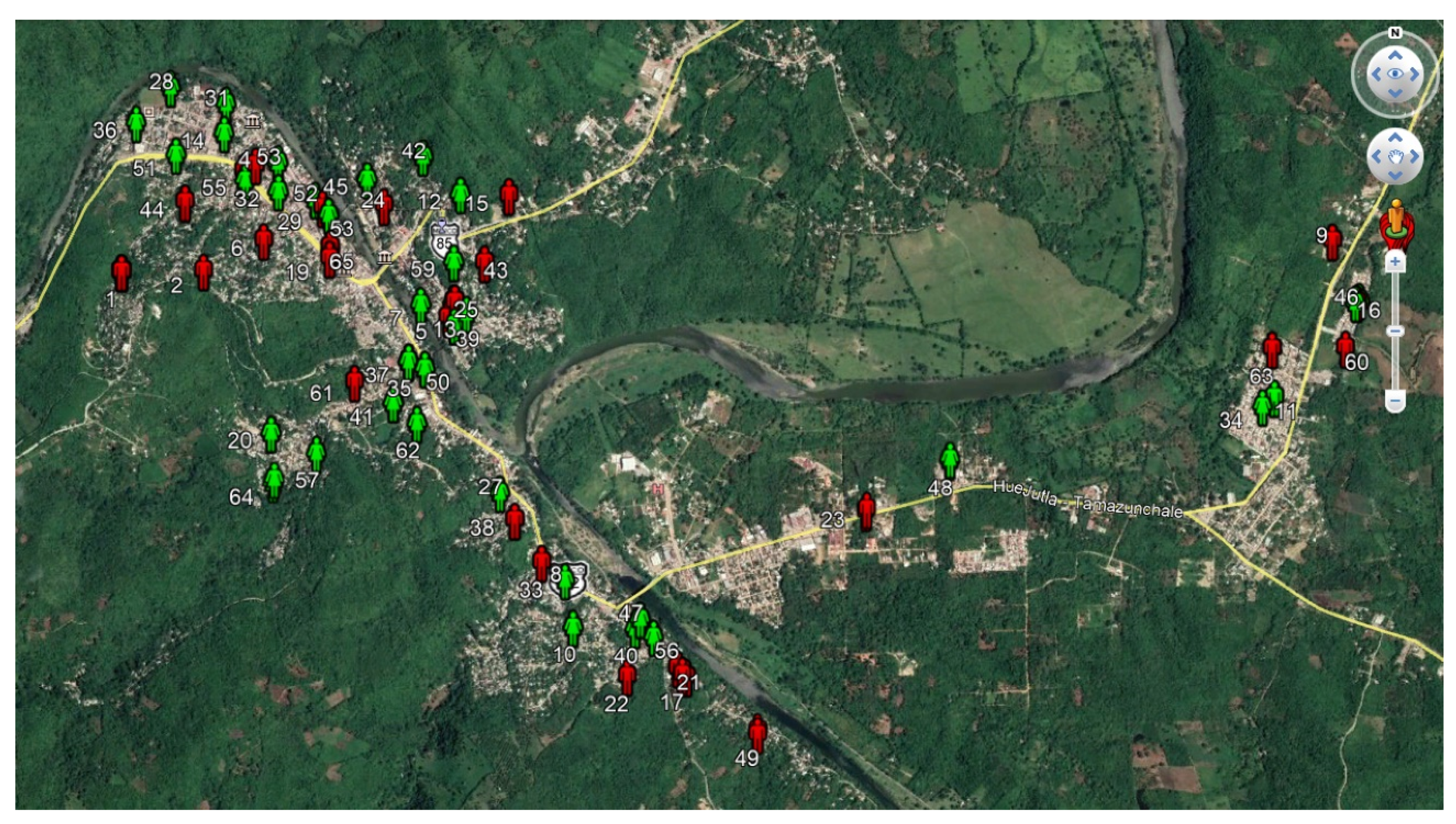

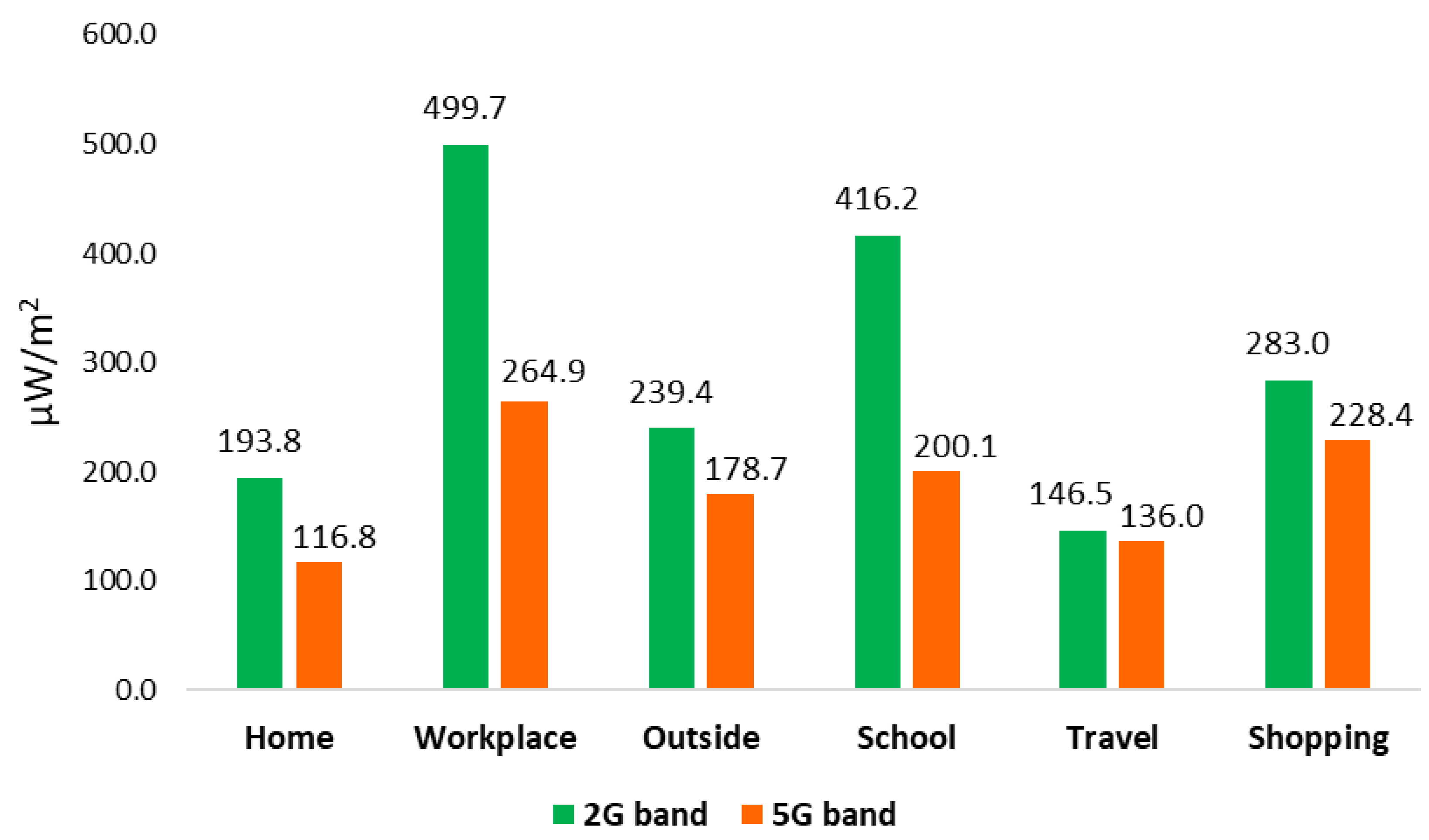

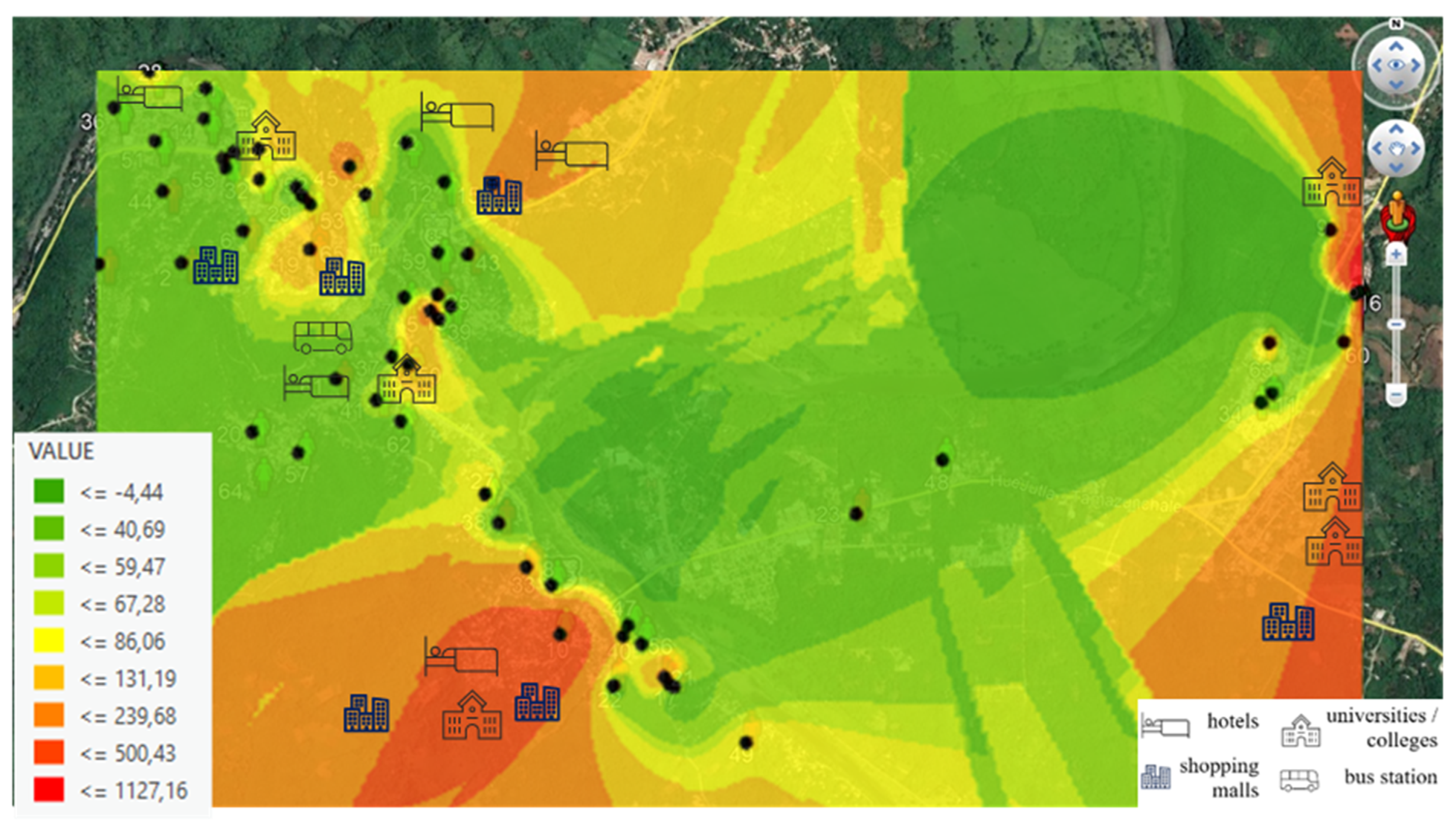
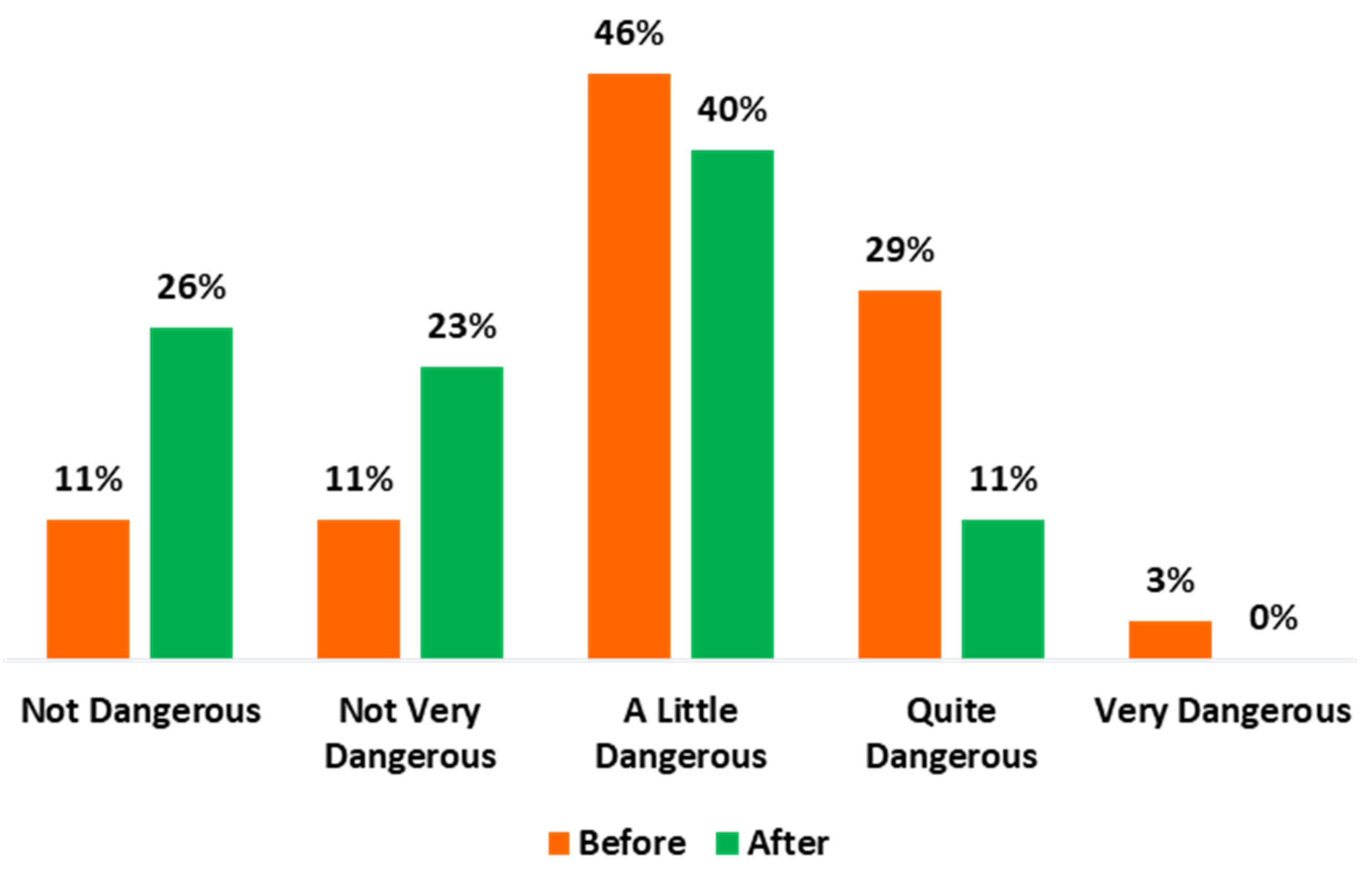
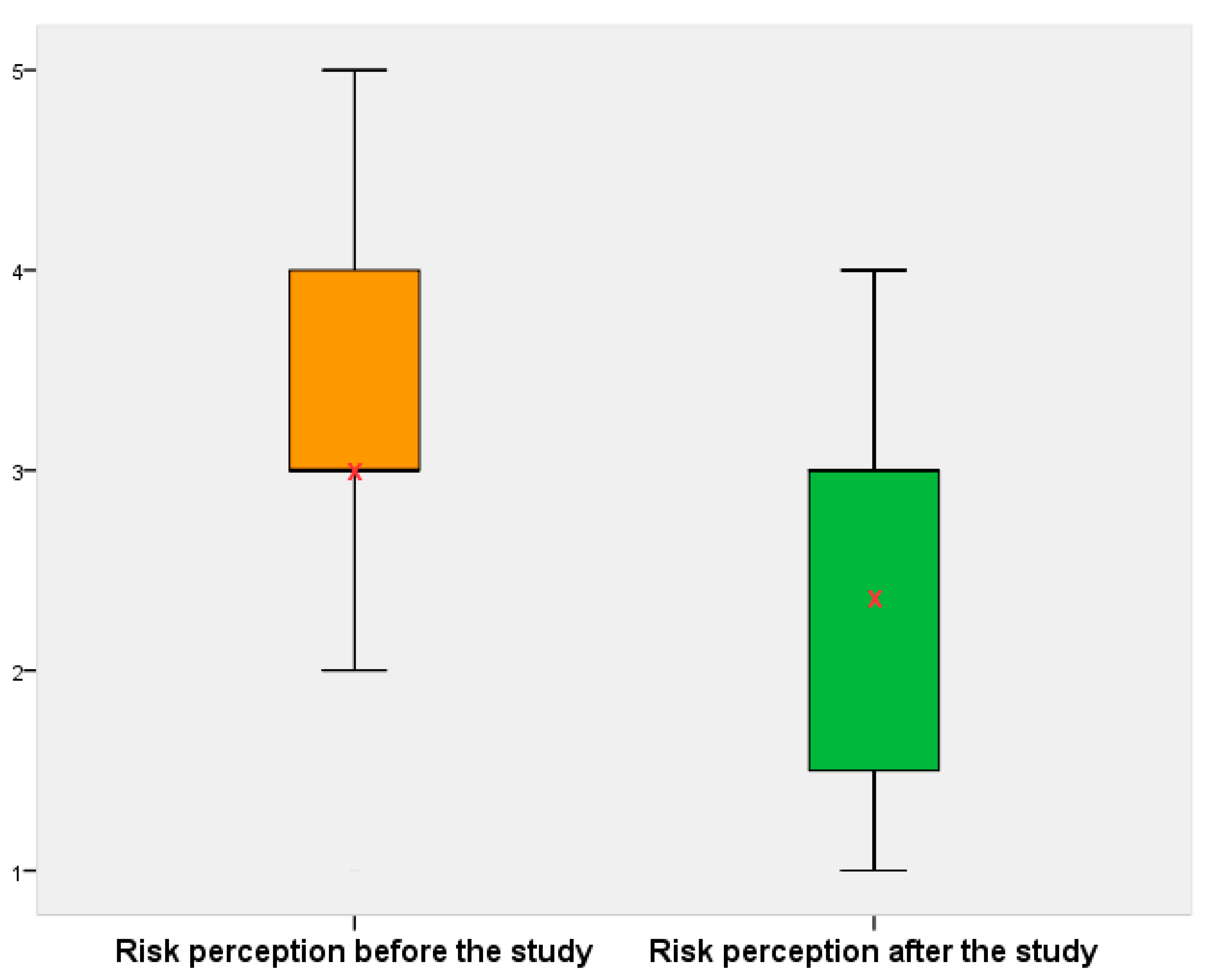
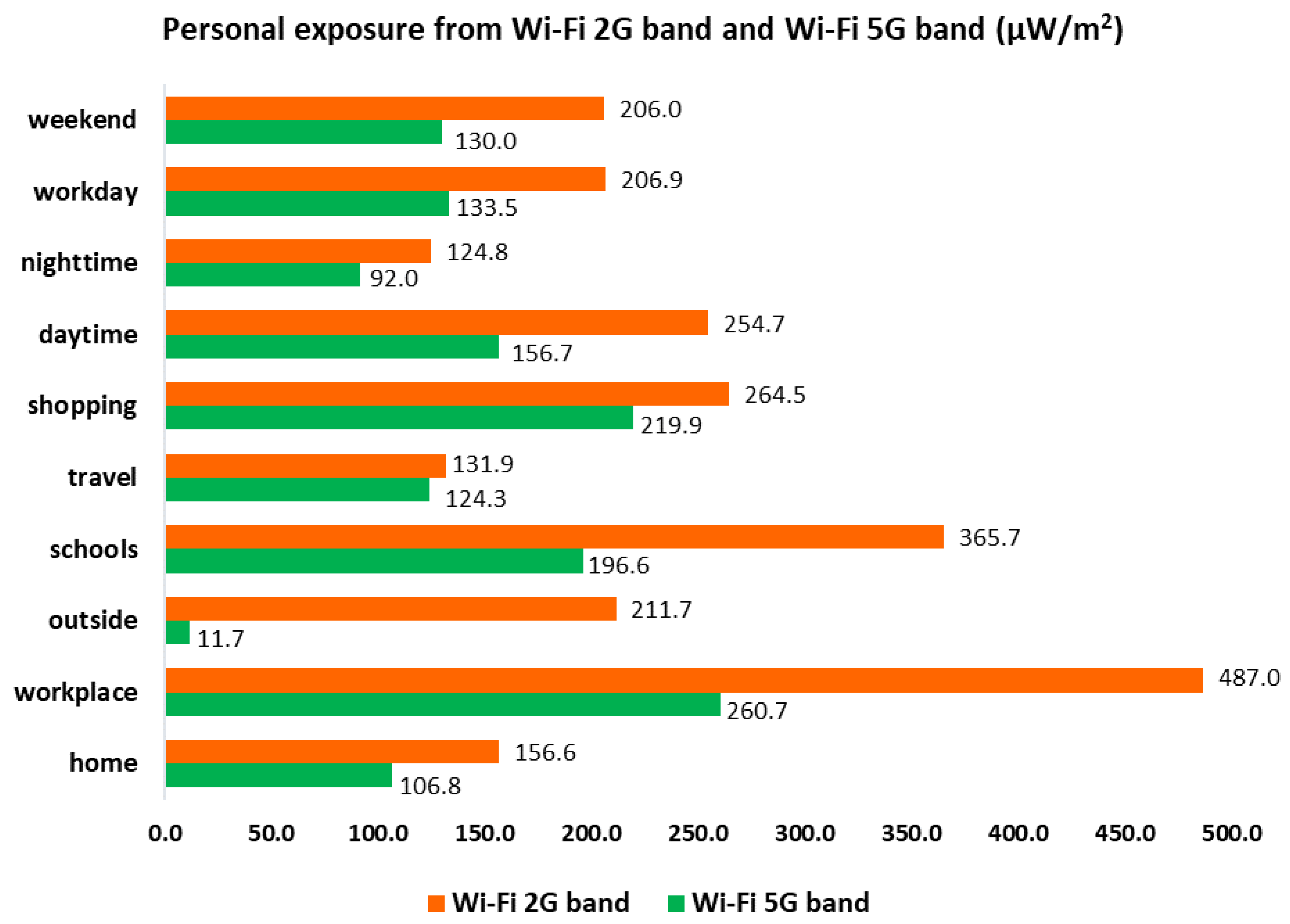
| Band | Description of Frequency Bands | Frequency (MHz) |
|---|---|---|
| FM | Radio broadcast transmitter | 88–108 |
| TV3 | Television broadcast transmitter | 174–223 |
| TETRA | Mobile communication for closed groups | 380–390 |
| TV4&5 | Television broadcast transmitter | 470–830 |
| GSM uplink | Transmission from handset to base station | 880–915 |
| GSM downlink | Transmission from base station to handset | 925–960 |
| DCS uplink | Transmission from handset to base station | 1710–1785 |
| DCS downlink | Transmission from base station to handset | 1805–1880 |
| DECT | Digital Enhanced Cordless Telecommunications | 1880–1900 |
| UMTS uplink | Transmission from handset to base station | 1920–1980 |
| UMTS downlink | Transmission from base station to handset | 2110–2170 |
| Wi-Fi 2G | Wireless local area network | 2400–2500 |
| WiMAX | Worldwide interoperability for microwave access | 3400–3800 |
| Wi-Fi 5G | Wireless local area network | 5150–5850 |
| Wi-Fi 2G Band | Wi-Fi 5G Band | |||||||
|---|---|---|---|---|---|---|---|---|
| Daytime | Nighttime | Workday | Weekend | Daytime | Nighttime | Workday | Weekend | |
| Min | 0 | 0 | 0 | 0 | 0.05 | 0.05 | 0.05 | 0.53 |
| Mean | 303.1 | 129.4 | 245.2 | 218.0 | 168.3 | 93.9 | 143.0 | 133.6 |
| Mode | 0.1 | 0.1 | 0.1 | 0.1 | 0.5 | 0.5 | 0.5 | 0.5 |
| SD | 2400 | 1400 | 2100 | 1700 | 1600 | 1200 | 1500 | 1300 |
| P5 | 0.1 | 0.1 | 0.1 | 0.1 | 0.5 | 0.5 | 0.5 | 0.5 |
| P50 | 0.45 | 0.07 | 0.27 | 0.1 | 0.53 | 0.53 | 0.53 | 0.53 |
| P90 | 315.7 | 55.8 | 215.5 | 61.3 | 73.1 | 28.1 | 72.2 | 15.7 |
| P95 | 1090 | 230.8 | 776.3 | 566.2 | 401.4 | 200.6 | 367.1 | 112.6 |
| P99 | 5650 | 2820 | 4425 | 5500 | 3360 | 1430 | 2470 | 3350 |
| Max | 66,300 | 66,300 | 66,300 | 66,300 | 66,300 | 66,300 | 66,300 | 66,300 |
| Wi-Fi 2G Band | Wi-Fi 5G Band | |||||||||||
|---|---|---|---|---|---|---|---|---|---|---|---|---|
| Home | Workplace | Outside | School | Travel | Shopping | Home | Workplace | Outside | School | Travel | Shopping | |
| Min | 0 | 0 | 0 | 0 | 0 | 0.01 | 0.05 | 0.53 | 0.05 | 0.05 | 0.05 | 0.53 |
| Mean | 193.8 | 499.7 | 239.4 | 416.2 | 146.5 | 283.0 | 116.8 | 264.9 | 178.7 | 200.1 | 136.0 | 228.4 |
| Mode | 0.1 | 0.1 | 0.1 | 0.1 | 0.1 | 0.1 | 0.5 | 0.5 | 0.5 | 0.5 | 0.5 | 0.5 |
| SD | 2000 | 2300 | 2300 | 2300 | 1500 | 1600 | 1500 | 1500 | 1800 | 1700 | 1400 | 1300 |
| P5 | 0.1 | 0.1 | 0.1 | 0.1 | 0.1 | 0.1 | 0.5 | 0.5 | 0.5 | 0.5 | 0.5 | 0.5 |
| P50 | 0.13 | 2.08 | 0.07 | 2.55 | 0.17 | 0.45 | 0.53 | 0.53 | 0.53 | 0.53 | 0.53 | 0.53 |
| P90 | 98.8 | 1292.3 | 98.1 | 722.8 | 71.3 | 155.5 | 32.1 | 371.02 | 49.1 | 156.6 | 61.3 | 104.7 |
| P95 | 397.3 | 2279 | 324.9 | 1630 | 409.7 | 1738 | 218.5 | 1296 | 164.1 | 554.0 | 351.4 | 590.9 |
| P99 | 3970 | 7870 | 6530 | 6940 | 3230 | 7490 | 1710 | 4890 | 41,640 | 3930 | 2440 | 7590 |
| Max | 66,300 | 66,300 | 66,300 | 66,300 | 66,300 | 66,300 | 66,300 | 66,300 | 66,300 | 66,300 | 66,300 | 21,200 |
| Publication | Location | Minimum Value | Maximum Value |
|---|---|---|---|
| Ramirez-Vazquez, et al., 2019 [21] | Albacete (with volunteers) | 3.9 (Wi-Fi band) | 86.9 (Wi-Fi band) |
| Ramirez-Vazquez, et al., 2019 [45] | Albacete (mobile phone base stations during temporary events) | 29.0 (DCS-DL band) | 1114 (GSM-DL band) |
| Ramirez-Vazquez, et al., 2020 [79] | Albacete (school building: inside and outside) | 0.61 (Wi-Fi band) | 121 (Wi-Fi band) |
| Ramirez-Vazquez, et al., 2020 [50] | Jordan (University area) | 1.41 (Wi-Fi band) | 385 (Wi-Fi band) |
| Verloock et al., 2014 [78] | Belgium (Public places) | 53.05 (Wi-Fi band) | 13,580 (Wi-Fi band) |
| This paper | Mexico (with volunteers) | 93.3 (Wi-Fi band) | 500 (Wi-Fi band) |
Publisher’s Note: MDPI stays neutral with regard to jurisdictional claims in published maps and institutional affiliations. |
© 2021 by the authors. Licensee MDPI, Basel, Switzerland. This article is an open access article distributed under the terms and conditions of the Creative Commons Attribution (CC BY) license (http://creativecommons.org/licenses/by/4.0/).
Share and Cite
Ramirez-Vazquez, R.; Gonzalez-Rubio, J.; Escobar, I.; Suarez Rodriguez, C.d.P.; Arribas, E. Personal Exposure Assessment to Wi-Fi Radiofrequency Electromagnetic Fields in Mexican Microenvironments. Int. J. Environ. Res. Public Health 2021, 18, 1857. https://doi.org/10.3390/ijerph18041857
Ramirez-Vazquez R, Gonzalez-Rubio J, Escobar I, Suarez Rodriguez CdP, Arribas E. Personal Exposure Assessment to Wi-Fi Radiofrequency Electromagnetic Fields in Mexican Microenvironments. International Journal of Environmental Research and Public Health. 2021; 18(4):1857. https://doi.org/10.3390/ijerph18041857
Chicago/Turabian StyleRamirez-Vazquez, Raquel, Jesus Gonzalez-Rubio, Isabel Escobar, Carmen del Pilar Suarez Rodriguez, and Enrique Arribas. 2021. "Personal Exposure Assessment to Wi-Fi Radiofrequency Electromagnetic Fields in Mexican Microenvironments" International Journal of Environmental Research and Public Health 18, no. 4: 1857. https://doi.org/10.3390/ijerph18041857
APA StyleRamirez-Vazquez, R., Gonzalez-Rubio, J., Escobar, I., Suarez Rodriguez, C. d. P., & Arribas, E. (2021). Personal Exposure Assessment to Wi-Fi Radiofrequency Electromagnetic Fields in Mexican Microenvironments. International Journal of Environmental Research and Public Health, 18(4), 1857. https://doi.org/10.3390/ijerph18041857









